Leslieville Community Rapid Testing Program
Sign up and get free, at-home rapid tests for twice-weekly asymptomatic COVID testing for Leslieville PS students and their unvaccinated family members.This is a caregiver-led initiative NOT affiliated with Toronto Public Health or the LPS school council. As a volunteer community organization, we can assume no responsibility for your interpretation or use of rapid tests we provide. Please read and follow the test instructions carefully.These tests do not replace testing at an official testing centre and are specifically intended for students and unvaccinated family members who do not have symptoms of COVID-19.This initiative was started with a total of 2500 rapid tests, ordered prior to the announcement by the Ministry of Health on Sept 29th that they will not be providing additional rapid tests to students. As such, we may only be able to support the program for a limited period of time while we have availability of test kits. We will keep you closely posted on the status of our supply.
How Testing Works
Step 1: Sign up for tests:
HERE
We will need your contact info, number of unvaccinated people in your household requiring testing, and your preferred pick up time.Step 2: Pick up your tests every week
Pick up your tests from parents in the community at designated pick-up times.Step 3: Test your kids twice weekly
Use rapid tests and instructions to test your asymptomatic family members with no known exposures for COVID-19 twice a week. We recommend Monday and Thursday mornings before school. How do you give the test? Find more info HERE.Step 4: Report your results
-Report any positive OR negative test result to Michael Garron Hospital using this secure form.
-Inconclusive result? Email us at lpsrapidtest@gmail.com for another test.
Test Instructions
BEFORE YOU TEST
Store tests in a safe place that is not too hot or cold, between 2 and 30 degrees Celsius.Keep the tubes upright, for example in a cup, so they don’t leak.Make sure children cannot drink the fluid in the tubes or get it in their eyes or on their skin.WHEN TO TEST
We recommend that you test on Monday and Thursday mornings.
STEP 1: GATHER YOUR SUPPLIES
You will need:
- 1 test device (small foil package)
- 1 extraction tube (blue and white caps)
- 1 nasal swab for sample collection (sealed package)Sanitize your hands and work surface.
Open the foil pouch containing the test device.
STEP 2: COLLECT YOUR SAMPLE, PICK YOUR METHODMethod 1: Oral-Nasal Swab
Michael Garron Hospital has tested an oral nasal swab that is more comfortable for children and may be more accurate. Older children may be able to do it themselves.1.Insert swab into mouth and press swab on back of tongue while drawing five circles.
2. Keeping swab in mouth, press swab to inside of one cheek while drawing five circles.
3. Repeat with second cheek.
4. Insert the same swab into the front of one nostril and press against the nostril wall while rubbing in circles three times.
5. Repeat with second nostril.This YouTube video shows the oral nasal swab.
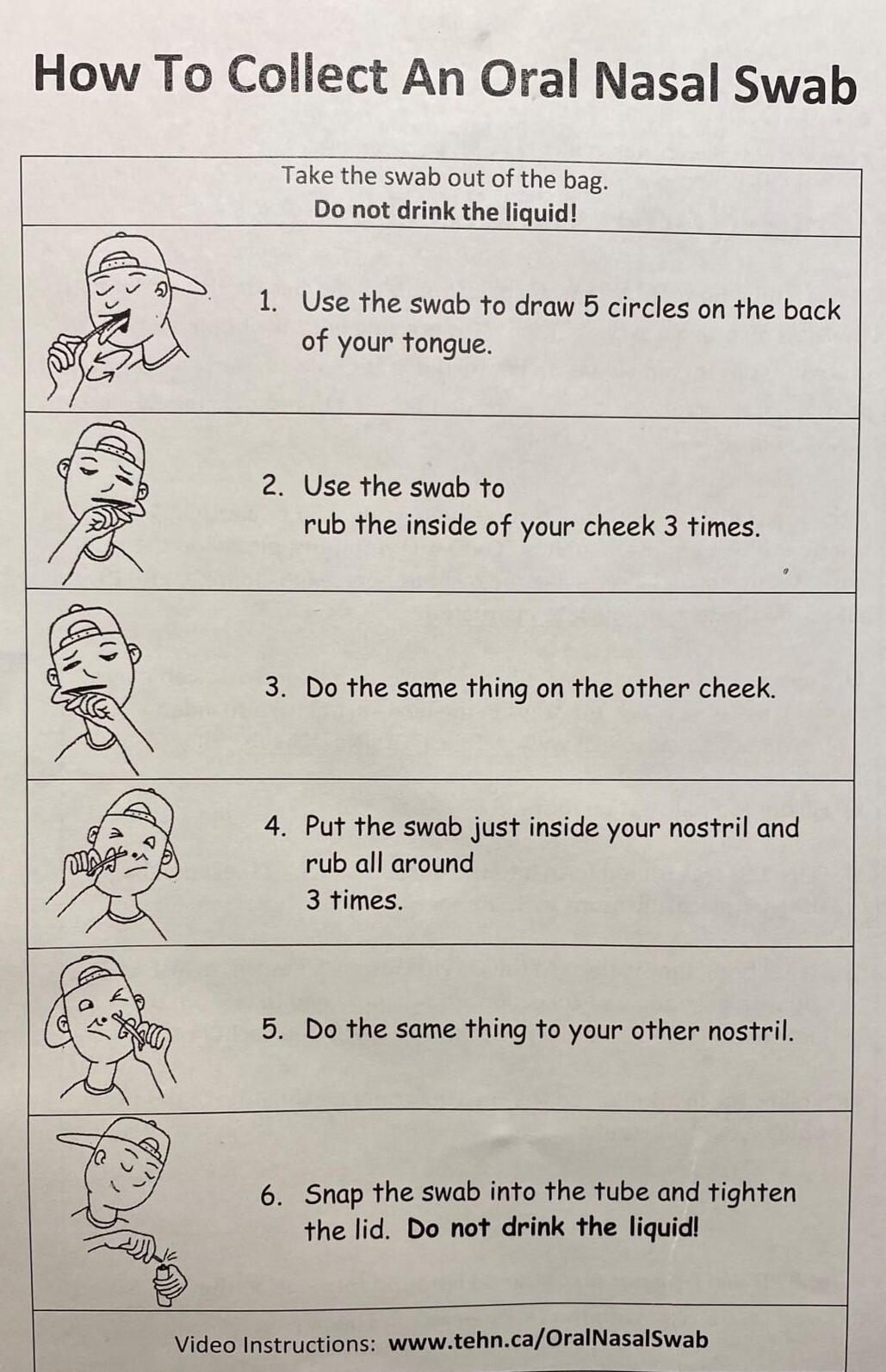
Method 2: Nasal Swab
1. Tilt head back 70 degrees. While gently rotating, insert the swab less than one inch, or about 2cm, into the nostril until you feel resistance.
2. Rotate the swab 5 times against the nasal wall.
3. Using the same swab, repeat with the second nostril.
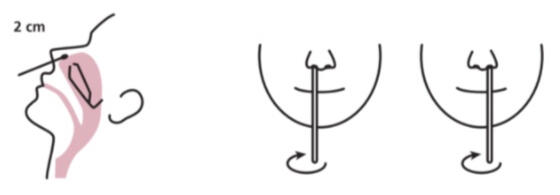
STEP 3
1. Unscrew the blue lid of the extraction tube, being careful not to spill any of the buffer solution, and insert the swab.
2. Swirl the swab tip in the buffer fluid inside the tube, pushing the swab into the wall of the tube at least five times.
3. Squeeze out the swab by squeezing the middle of the extraction tube with your fingers.
4. Break the swab at the breakpoint by bending it, and close the (blue) cap of the extraction tube, leaving the bottom end of the swab in the tube.
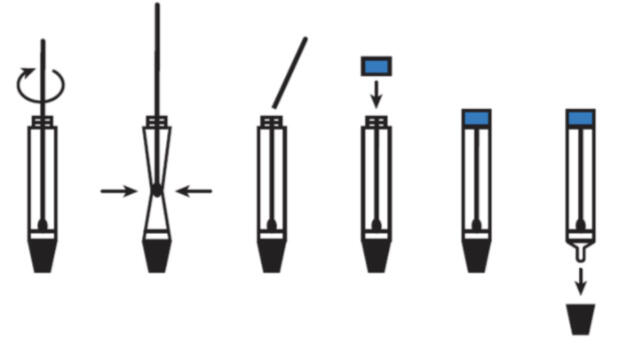
STEP 4
1. Keeping the tube upright, open the dropping nozzle (white) cap at the bottom and dispense 5 drops of the fluid into the round specimen well of the test device, labelled with ‘S’.
2. If you can’t get 5 drops out there may be a blockage. You can gently shake the tube to remove the blockage.
3. Close the tube and dispose.
Start a timer for 15 minutes. Do not handle or move the test device until the test is completed and ready for reading.
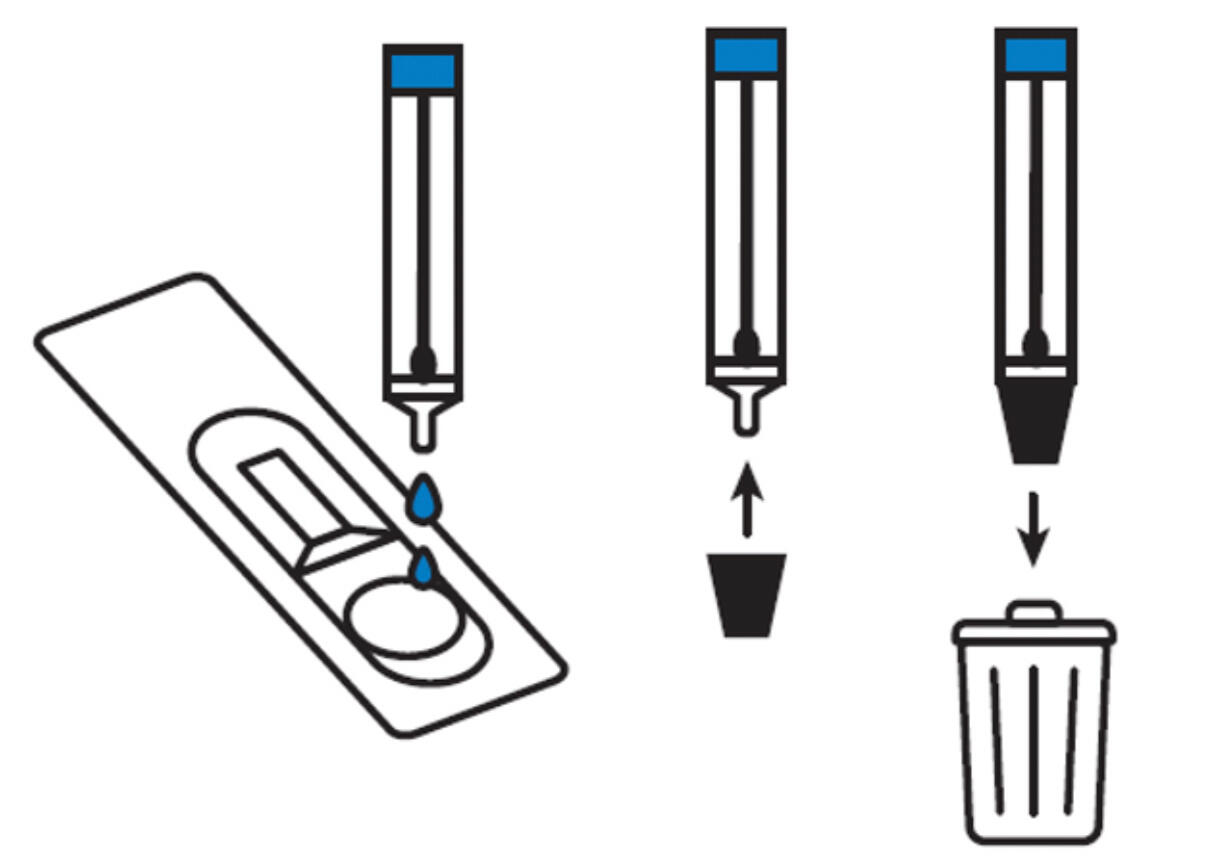
Start a timer for 15 minutes. Do not handle or move the test device until the test is completed and ready for reading.
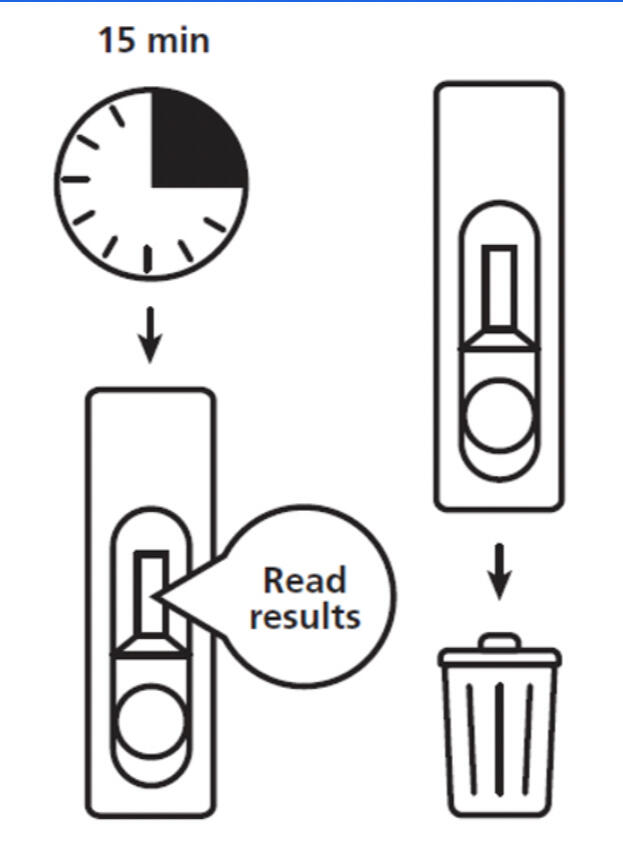
STEP 5
After 15 minutes, read the result using the image below. Dispose of the used kit.Please note: Do not read the results more than 20 minutes after applying the drops to the testing advice.
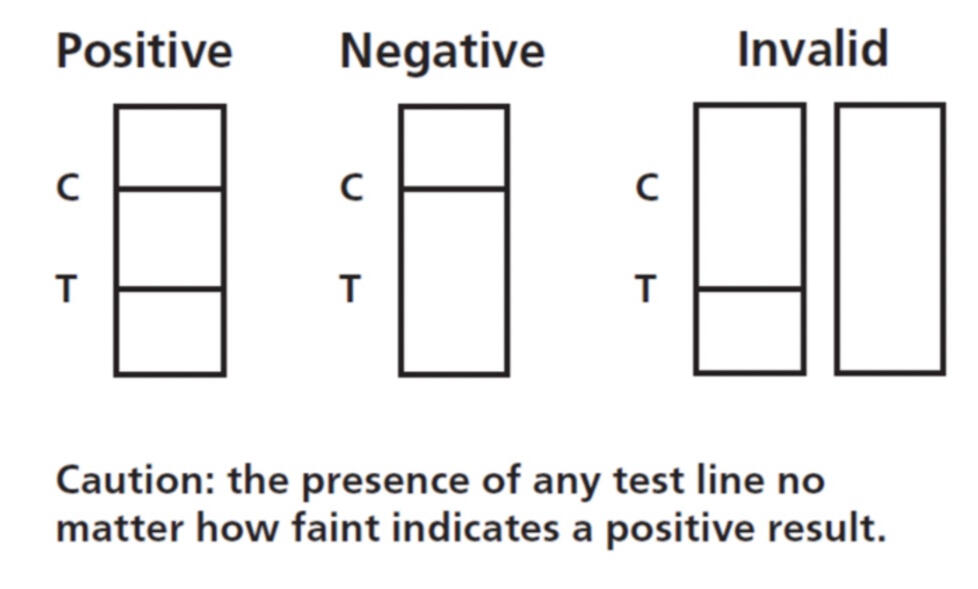
Result Interpretation
- A “C” (control) line alone means it is negative.
- A “C” (control) line and a “T” (test) line means it is positive, and detected the COVID virus.
- A missing “C” (control) line means the test did not work.Caution: If you can see any test (“T”) line, no matter how faint, the test is positive.
PDF instructions provided by StaySafe are here that you can print. You can replace Step Two with the oral-nasal swab instructions listed above.
What to do if the test is NEGATIVE:
You do not need to report negative test results. Send your kids off to school or daycare, feeling great that you’ve helped make the Leslieville PS community safer!What to do if the test is POSITIVE:
1. Isolate the child and any unvaccinated family members. Do not send them to school or daycare.
2. Bring your child to an assessment centre to have another COVID test. False results are rare, but they can happen.
3. Report the positive result to Michael Garron Hospital using this secure form. Leslieville PS Rapid Testing program will never be told who has tested positive.
Frequently asked questions
Who are we, and why are we running this program?
We are concerned parents who want to facilitate home-based asymptomatic testing for the virus that causes COVID-19, SARS-Cov-2, in our community. We are doing this because studies show that asymptomatic kids and adults can transmit the virus. Frequent testing is one way to identify infected individuals who have no symptoms or known exposure but may be transmitting the virus. Along with following school board guidelines for symptom screening, getting vaccinated, and getting tested at a testing centre when advised to, frequent home-based testing of asymptomatic individuals is one way to do our part to make sure we are not accidentally spreading COVID-19 to other kids and staff at schools.What is asymptomatic testing and how will it be done? Is it appropriate for schools? How is it different from diagnostic testing?
Asymptomatic testing, sometimes called test-based screening or surveillance testing, is the use of tests on individuals who do not currently have COVID-19 symptoms or a known exposure to identify asymptomatic or presymptomatic cases of COVID-19. We are facilitating this by supplying parents with rapid antigen tests that can be done at home in about 15 minutes. Because many children are asymptomatic, frequent use of rapid antigen tests can identify infected individuals earlier than symptom- or outbreak- based screening. Identifying a potentially positive case through a rapid antigen test helps prevent the spread of SARS-Cov-2 in the classroom. Regular asymptomatic testing has been used in schools across the United States, England, and Germany, and is currently used in many workplaces and in some schools in Canada.Diagnostic testing such as that done at a testing centre typically uses more sensitive testing technologies (e.g. PCR) and is currently being recommended only when there is a reason to believe that an individual may be infected (e.g. symptoms or a known exposure).Our program is an additional method of screening, along with those recommended by schools, not a diagnostic program. It does not replace diagnostic testing when diagnostic testing is recommended by school and public health guidelines. Instead, it aims to identify infections among individuals who would not otherwise have been tested according to school and public health guidelines.How does the program work?
First, you register for the program. Weekly you order and pick up a one-week supply of (2) rapid antigen tests for each child in your household from our volunteer organizers, who are all LPS Rapid Testing volunteers. Test children twice weekly, ideally in the morning, to screen each child in your household who is in school or child care. If any test is positive, you should follow public health protocols: isolate your child and any unvaccinated household members and seek confirmation testing at a testing centre or using take-home tests provided by the school. Report your results weekly before picking up your next weekly supply of tests.Children who are advised to be tested by school or public health guidelines should not use these tests; they should visit a testing centre.Who are these tests for?
These tests are for students at Leslieville PS and their unvaccinated siblings who fit all of the criteria below:
- Asymptomatic
- Have no knowledge of exposure to COVID-19
- Have not been advised to be tested by school or public health guidelinesOur goal is to provide Leslieville PS families with enough tests to be used twice weekly to screen asymptomatic children who have no knowledge of COVID-19 exposure and have not been advised to be tested by school and public health guidelines. Regular rapid testing is an extra measure that can help reduce the spread of COVID-19 between children who are mixing in these settings. Siblings and other family members may also be screened.Children who have been advised to be tested by school or public health guidelines should not use these tests -- they should visit a testing centre as instructed by the school or local health unit.Is there a cost for using this program? Where do the tests come from?
No, there is no cost for using this program. We were able to secure tests through a community organization called StaySafe™, based in Kitchener-Waterloo, that distributes to businesses and community groups. Unfortunately, the government has discontinued the distribution for the use in students. We only have 1500 tests, and may not be able to continue the program without test kits. Call your MPP, write emails, and sign this petition if you wish to advocate for uninterrupted rapid tests in schools.What are the tests used in the program? Are they hard to use? How long does it take for results?
The tests used in the program are called “rapid antigen tests.” They are designed to detect proteins in the virus that causes COVID-19. We are currently distributing the Abbott Panbio tests, which are approved by Health Canada. The tests use a shallow nasal swab that is inserted about 1 inch (2.5 cm) into the nose (or less for small children). Most adults and kids find them easy to use; they are painless and often cause a funny tickle or sneeze.Michael Garron Hospital has advised us that you can use the oral-nasal swab technique used for children (tongue, cheeks, and outer part of nostrils) with these tests.Results are available in 15 to 20 minutes.When should these tests be used?
We are initially supplying tests for use twice weekly. Because an infection that is at an early pre-contagious stage might be missed by the tests, a testing result becomes less informative as time passes, so testing will work best if it is done in the morning before school and scheduled to avoid long gaps between tests. We suggest testing in the morning before going to school on Monday and Thursday. If your child does not attend school on a planned testing day for some reason, move the test to the next day they return to school.What do I do if my child tests positive on a rapid antigen test?
If your rapid antigen test returns a positive result, do all of the following:Isolate your child and any unvaccinated household members; do not send them to school.Seek follow-up PCR testing at a testing centre to confirm the test result. Follow public health and school guidance regarding the reporting of confirmation test results.Don’t forget to include the positive result when reporting results before your next order/pickup.While rapid antigen tests are highly specific, about 1 in 1000 tests done on uninfected people will show a positive.What data does the program collect?
Our program collects only the minimal information necessary to effectively distribute tests - a parent name, contact email, and number of children requiring testing. We also collect weekly testing results per family (total # of tests performed, # negative, # positive, # inconclusive) and aggregate those numbers across the Leslieville Community for reporting to StaySafe, the test kit provider.Why should I participate in this program?
Up to half of children infected with COVID-19 will have no detectable symptoms, and those who eventually do develop symptoms can spread the disease before they are symptomatic. Regular screening using rapid antigen tests can prevent infectious children from getting other kids, school staff, or family members sick. If your child screens positive, you may just have prevented their friends and classmates from getting sick. The greater number of children tested regularly, the safer our schools will become.Can I use these tests instead of going to a testing centre if my child has symptoms that qualify under public health guidelines for an official test, or other symptoms that are concerning?
No. These tests are for regular asymptomatic screening only of people with no known exposure who do not qualify under school and public health guidelines for a test. Symptomatic children should be tested at official testing centres. Please follow school and public health guidelines regarding children who have symptoms, known exposures, or have travelled recently. The rapid antigen tests used by our program are less sensitive (will fail to detect more infections) than the PCR tests used at testing centres.Can I use these tests if my child has had a recent exposure to a known or suspected case, or has travelled outside of the country, to “clear” them?
No. These tests are for regular asymptomatic screening only of people with no known exposure. Please follow school and public health guidelines regarding children who have had exposures or travelled recently and seek testing at a testing centre if advised. Rapid antigen tests are less sensitive (will fail to detect more infections) than the PCR tests used at testing centres and with school-provided collection kits.What does a negative test mean? Does a negative test mean that my child doesn’t need to wear a mask or take other precautions?
Rapid antigen tests are not as sensitive as the PCR tests used at testing centres - in other words, our tests may miss some infections. Because an antigen test is not a guarantee that a child is not infectious, and furthermore does nothing to protect the child from becoming infected in the future, children with negative tests must still mask and take other precautions including distancing. Moreover, a negative test result is a snapshot in time; children may become infected subsequently or may already be incubating an infection that is not yet detectable. Again, if your child has symptoms, a known exposure, or other reasons that qualify them for an official test, please get them tested at a testing centre or using a school-provided collection kit.I'm vaccinated and all the other parents in my community are also vaccinated. There's no way for any children to get infected, so is this really necessary?
Emerging evidence shows that breakthrough infections (infections in vaccinated individuals) do occur, particularly with the Delta variant. Vaccination provides excellent protection against severe illness but does not necessarily protect vaccinated people from transmitting COVID-19. Additionally, kids may get infected from others in their day to day interactions including those who are not yet vaccinated.This is a great idea! How can I help?
There is a lot to do! Besides spreading the word to other families in the Leslieville PS Community, you could volunteer to host a pick-up location or volunteer to help repackage tests. See the Volunteer section if you'd like to join us!
Interested in Helping out?
Any other questions?
We are happy that you're willing to help! We welcome others who are willing to help with any of the following tasks:-Hosting a regular pick-up location
-Repackaging tests for distribution
-Trying to source rapid tests
-Spreading the word
-Translation of website/informationIf you have other skills you think might be of use, please feel free to contact us as well.Please send any volunteering or any other inquiries below!